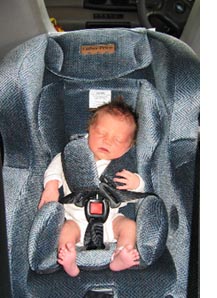|
Transporting your baby home
Where possible, you should always use a rear-facing baby car seat, even on short journeys. If you do not own a car, it may be possible to borrow or hire a baby seat if travelling by taxi.
 Premature baby charity BLISS makes the following recommendations when transporting your baby by car: Premature baby charity BLISS makes the following recommendations when transporting your baby by car:
- Try your baby in the car seat before going home to make sure that he/she is safe and comfortable.
-
Use 'head hugger' supports which fix into car seats if your baby is still quite small.
- Practice fitting the baby seat into your car.
- Only use a rear-facing baby seat for a newborn baby.
-
Never use a baby seat in the front if a passender seat airbag is fitted.
-
Do not buy or use a second hand baby seat unless you are fully aware of its history.
Research has indicated that certain babies can have breathing problems if they stay in a car seat for long periods. The Royal Society for the Prevention of Accidents (RoSPA) has issued guidelines in the use of car seats for premature and low birthweight babies:
-
Avoid keeping your baby in the seat for any longer than is necessary.
- Recline the seat as much as possible when in the car.
- Never leave your baby unattended in the car seat.
-
Only use the baby seat in the car and not on an integrated travel system for feeding or sleeping.
-
Keep car travel to a minimum for the first few months where possible.
|



